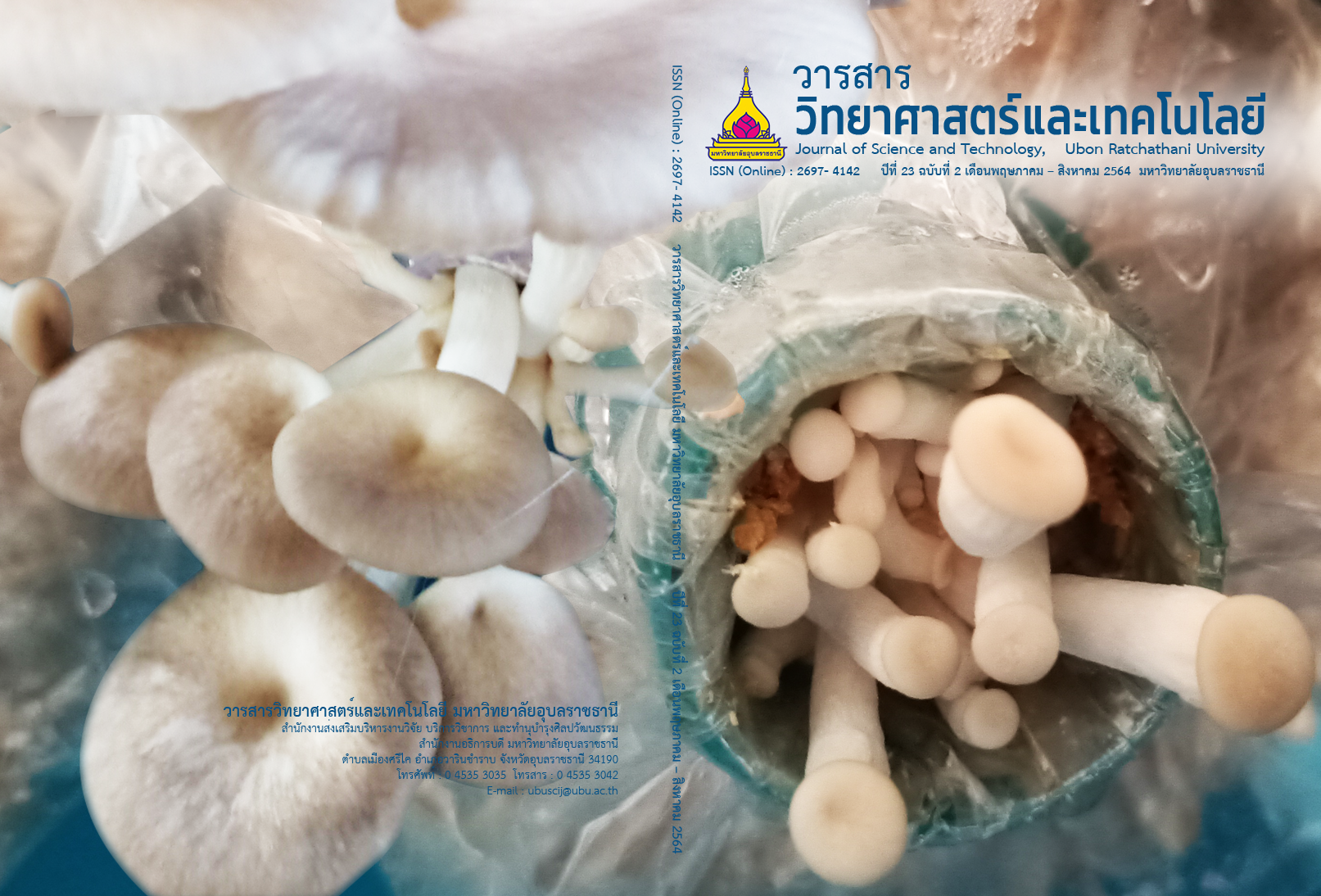การศึกษาชนิดและปริมาณขยะทะเลบริเวณสถานตากอากาศบางปู อำเภอเมืองสมุทรปราการ จังหวัดสมุทรปราการ
Main Article Content
บทคัดย่อ
ขยะทะเลเป็นปัญหาสำคัญที่ส่งผลต่อทัศนียภาพ เศรษฐกิจ การท่องเที่ยว สุขภาพอนามัย และสิ่งแวดล้อมทางทะเลโดยเฉพาะในแหล่งท่องเที่ยวทางทะเลและชายฝั่งที่มักจะเกิดปัญหาการสะสมของขยะทางทะเลจากกิจกรรมต่าง ๆ ในพื้นที่ งานวิจัยนี้จึงได้ทำการศึกษาชนิดและปริมาณขยะทะเลในสถานตากอากาศบางปู อำเภอเมืองสมุทรปราการ จังหวัดสมุทรปราการ โดยการวางแปลงสำรวจขนาด 3x3 เมตร ศึกษาชนิดและปริมาณของขยะที่สะสมในพื้นที่และขยะที่มากับกระแสน้ำ แล้วนำมาจำแนกตามกิจกรรมที่ก่อให้เกิดขยะโดยใช้แบบสำรวจของ International Coastal Cleanup (ICC) ทำการเก็บตัวอย่างครั้งที่ 1 (สิงหาคม พ.ศ. 2562) และครั้งที่ 2 (เมษายน พ.ศ. 2563) ผลการศึกษาพบว่าชนิดของขยะทะเลจำแนกตามประเภทขยะที่พบมากที่สุดคือ ภาชนะบรรจุอาหาร และถุงพลาสติก โดยกิจกรรมที่ก่อให้เกิดขยะคือ กิจกรรมชายฝั่งและการพักผ่อน (90.77-96.42%) การจำแนกวัสดุของขยะพบว่าส่วนใหญ่เป็นขยะพลาสติก (75.40-90.30%) ผลการศึกษาปริมาณขยะทะเลพบว่าจำนวนและน้ำหนักขยะทะเลทั้งขยะที่สะสมและขยะที่มากับกระแสน้ำจากการเก็บตัวอย่างครั้งที่ 1 มากกว่าครั้งที่ 2 อย่างมีนัยสำคัญทางสถิติ (p<0.5) โดยจำนวนขยะสะสมเฉลี่ยเท่ากับ 2.1 และ 0.4 ชิ้น ต่อตารางเมตร ตามลำดับ ส่วนจำนวนขยะที่มาจากกระแสน้ำมีค่าเฉลี่ยเท่ากับ 1.38 และ 0.36 ชิ้นต่อตารางเมตร ตามลำดับ โดยมีการสะสมของขยะจำนวนมากในแนวน้ำขึ้นสูงสุด ผลที่การศึกษาครั้งนี้จะเป็นข้อมูลสภาพปัญหา และสถานการณ์ปัญหาขยะทะเลในพื้นที่ เพื่อหาแนวทางในการป้องกัน แก้ไข และลดผลกระทบที่เกิดขึ้นจากปัญหาขยะทะเลอย่างเป็นระบบต่อไป
Article Details
บทความที่ได้รับการตีพิมพ์เป็นลิขสิทธิ์ของ วารสารวิทยาศาสตร์และเทคโนโลยี มหาวิทยาลัยอุบลราชธานี
ข้อความที่ปรากฏในบทความแต่ละเรื่องในวารสารวิชาการเล่มนี้เป็นความคิดเห็นส่วนตัวของผู้เขียนแต่ละท่านไม่เกี่ยวข้องกับมหาวิทยาลัยอุบลราชธานี และคณาจารย์ท่านอื่นๆในมหาวิทยาลัยฯ แต่อย่างใด ความรับผิดชอบองค์ประกอบทั้งหมดของบทความแต่ละเรื่องเป็นของผู้เขียนแต่ละท่าน หากมีความผิดพลาดใดๆ ผู้เขียนแต่ละท่านจะรับผิดชอบบทความของตนเองแต่ผู้เดียว
เอกสารอ้างอิง
[2] Jing Yi, C. and Kannan, N. 2016. Solid Waste Transportation through Ocean Currents: Marine Debris Sightings and their Waste Quantification at Port Dickson Beaches, Peninsular Malaysia. EnvironmentAsia. 9(2): 39-47.
[3] Thushari, G.G., and et al. 2017. Effect of Microplastics on Sessile Invertebrates in the Eastern Coast of Thailand: An Approach to Coastal Zone Conservation. Marine Pollution Bulletin. 124: 349–355.
[4] Tanyaros, S. 2014. Marine and Coastal Pollution. Trang: Rajamangala University of technology Srivijaya. (in Thai)
[5] Ocean Conservancy. 2010. Ocean Conservancy Guide to Marine Debris and International Coastal Cleanup. (The Office of Marine and Coastal Resources Conservation Department of Marine and Coastal Resources, Trans.). Bangkok: Department of Marine and Coastal Thailand. (in Thai)
[6] Wenneker, B. and Oosterbaan, L. 2010. Guideline for Monitoring Marine Litter on the Beaches in the OSPAR Maritime Area. London: OSPAR Commission.
[7] OSEAN/AMETEC. 2013. AMETEC Protocol on Beach Debris Monitoring. http://www.osean.net/bdlist/marine.php?ptype= view&code =newslitter2&idx=562. Accessed 24 May 2020.
[8] Jang, Y.C. and et al. 2018. Composition and Abundance of Marine Debris Stranded on the Beaches of Sri Lanka: Result from the First Island-Wide Survey. Marine Pollution Bulletin. 128: 126-131.
[9] Unger, A. and Harrison, N. 2016. Fisheries as a Source of Marine Debris on Beaches in the United Kingdom. Marine Pollution Bulletin. 107: 52–58.
[10] Cauwenberghe, L.V. and et al. 2013. Assessment of Marine Debris on the Belgian Continental Shelf. Marine Pollution Bulletin. 73:
161-169.
[11] Dehec, A.V. and et al. 2015. Composition and Potential Origin of Marine Debris Stranded in the Western Indian Ocean on remote Alphonse Island, Seychelles. Marine Pollution Bulletin. 96: 76-86.
[12] Iñiguez, M.E., Conesa, J.A. and Fullana, A. 2016. Marine debris occurrence and treatment: A review. Renewable and Sustainable Energy Reviews. 64: 394-402.
[13] Jambeck, J.R. and et al. (2015). Plastic waste inputs from land into the ocean. Science. 347(6223): 768-771.
[14] Booncherm, C., Vongpintu, V. and Nutpramoon, R. 2001. The Characteristic of the Sea Surface Residual Flow and the Circulation in the Gulf of Thailand from the Long Term Collected Data of the SEAWATCH Thailand Program, pp. 315-325. In: The 39th Kasetsart University Annual Conference, 5-7 February 2001. Bangkok, Thailand. (in Thai)
[15] Agustin, A.E. and et al. 2015. Temporal Variability of Marine Debris Deposition at Tern Island in the Northwestern Hawaiian Islands. Marine Pollution Bulletin. 101: 200–207.
[16] Lorpittayakorn, P. 2014. Circulation Patterns in the Gulf of Thailand from Model. Journal of Science and Technology. 23(3): 446-465.
(in Thai)
[17] Buranapratheprat, A. 2009. Circulation in the Bang Pakong River Mouth and Chonburi Coastal Area Investigated Using a Hydrodynamic Model. Burapha Science Journal. 14(2): 50-60. (in Thai)
[18] Galgani, F., Hanke, G. and Maes, T. 2015. Global Distribution, Composition, and Abundance of Marine Litter, pp. 29-56. In: M. Bergmann, L. Gutow and M. Klages (eds.) Marine Anthropogenic Litter. New York: Springer.
[19] Santos, L.R., Friedrich, A.C. and Ivar do Sul, J.A. 2009. Marine Debris Contamination along Undeveloped Tropical Beach from Northeast Brazil. Environmental Monitoring Assessment. 148: 455-462.
[20] Jayasiri, H., Purushothaman, C. and Venilla, A. 2013. Plastic Litter Accumulation on High Water Strandline of Urban Beaches in Mumbai, India. Environmental Monitoring Assessment. 185: 7709-7719.
[21] Thushari, G.G., Chavanich, S. and Yakupitiyage, A. 2017. Coastal Debris Analysis in Beaches of Chonburi Province, Eastern of Thailand as Implications for Coastal Conservation. Marine Pollution Bulletin. 116: 121-129.
[22] Jang, Y.C. and et al. 2014. Estimation of the Annual Flow and Stock of Marine Debris in South Korea for Management Purposes. Marine Pollution Bulletin. 86: 505–511.


